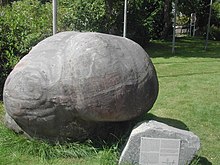Space land
|
Space land
City of Bad Berleburg
Coordinates: 51 ° 1 ′ 57 ″ N , 8 ° 23 ′ 10 ″ E
|
|
|---|---|
| Height : | 416 (400-550) m |
| Area : | 5.58 km² |
| Residents : | 1316 (December 31, 2017) |
| Population density : | 236 inhabitants / km² |
| Incorporation : | 1st January 1975 |
| Postal code : | 57319 |
| Area code : | 02751 |
|
Raumland in the 1930s
|
|

Raumland is a district of Bad Berleburg in the Siegen-Wittgenstein district , North Rhine-Westphalia ( Germany ).
Geographical location
It is located around 2 km south of Bad Berleburg on the southern slope of the Rothaar Mountains opposite the confluence of the Odeborn and the Eder . The place is surrounded by the extensive Sauerland-Rothaargebirge nature reserve .
history
Around 800, Raumland was first mentioned as Rumilingen (in rumilingene marca) in a deed of donation from Counts Reginghart and Meginhart to the Fulda Monastery . The first documentary mention can be found in the Codex Eberhardi from the 12th century. The church of Raumland was the original parish of the Upper Edertal , which belongs to the county of Wittgenstein . Your Martin's patronage points to a Franconian foundation. But the abundant settlement finds of recent times document a settlement of the favorably situated open spaces along the Eder from Meckhausen to Berghausen at least until the 8th century BC. Chr.
In the 13th century a local knight family can be traced (Ludwig von Raumland, Hermann von Raumland).
In 1624 there were 10 houses in Raumland, in 1819 there were 25 houses.
On January 1, 1975, Raumland was incorporated into Bad Berleburg.
Population development
| development | year | Residents | |||
|---|---|---|---|---|---|
 |
|||||
| 1819 | 183 | ||||
| 1900 | 287 | ||||
| 1961 | 764 | ||||
| 1970 | 986 | ||||
| 1974 | 1069 | ||||
| 2011 | 1460 | ||||
| 2017 | 1316 | ||||
|
The 1961 (June 6th) and 1970 (May 27th) figures are taken from the census results. 1974, source from 2011:. From 2017 to December 31 of the year. |
|||||
Attractions
- Slate - mine : The mine "dip" was mined from 1860 to 1923 slate. In 1890, the rail link in Raumland made transport easier and cheaper. Outside the pit that was gap house , in which the slates were split into sheets and processed. This split house is now inside the show mine. First a one-man drill, later a compressed air drill, was used for dismantling . A block was blown off by filling and igniting black powder . The only light the miners had was kerosene lamps. Today it is the only slate mine in the area. The Raumländer slate was famous for its quality and was delivered to London.
- Late Romanesque Protestant church with three aisles around 1240, probably the earliest example of the South Westphalian hall churches . In the modern roof turret, there are three bells cast around 1350, the oldest complete church bell ringing in Westphalia . Worth seeing wall paintings from the 15th century and a communion table from the 18th century.
literature
- Günther Wrede : Territorial history of the county of Wittgenstein. (= Marburg studies on older German history. Series 1: Works on the historical atlas of Hesse and Nassau. H. 3, ZDB -ID 506846-0 ). Elwert, Marburg 1927 (at the same time: Marburg, Phil. Diss., 1927).
- Fritz Krämer (Ed.): Raumland. Contributions to the history of our village. Zimmermann, Balve 1975.
- Hans Josef Böker: The late Romanesque wall pillar hall. In: Westphalia. 62, 1984, ISSN 0043-4337 , pp. 54-76.
- Schneider, Peter: Planned relocation of war-important operations for the underground armaments production of the Second World War in the Wittgenstein area. In: Wittgenstein, sheets of the Wittgensteiner Heimatverein e. V., Vol. 64/2000 / H. 1 / S. 12-19.
- Johannes Burkardt, Andreas Kroh, Ulf Lückel (ed.): The churches of the Wittgenstein church district in words and pictures. Grobbel, Bad Fredeburg 2001, ISBN 3-930271-86-9 .
Web links
- Raumland in the Westphalia culture atlas
- 360 ° panorama picture from the Bonifatiuskirche (Raumland) in the Kulturatlas Westfalen (requires Flash-Player )
Individual evidence
- ↑ a b Figures, data, facts - City of Bad Berleburg
- ↑ Wrede p. 173.
- ↑ Wrede p. 174.
- ↑ a b Federal Statistical Office (ed.): Historical municipality register for the Federal Republic of Germany. Name, border and key number changes in municipalities, counties and administrative districts from May 27, 1970 to December 31, 1982 . W. Kohlhammer, Stuttgart / Mainz 1983, ISBN 3-17-003263-1 , p. 337 .
- ↑ Martin Bünermann, Heinz Köstering: The communities and districts after the municipal territorial reform in North Rhine-Westphalia . Deutscher Gemeindeverlag, Cologne 1975, ISBN 3-555-30092-X , p. 138 .




